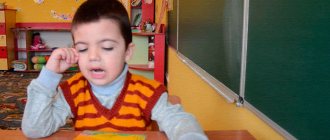Norms of speech development in preschool age
Children aged 4–5 years speak more correctly and more variedly, pronounce sounds more clearly, but some of them (“r”, “l”) can be distorted in words. The guys speak more coherently, they can compose a short story based on a picture, retell a fairy tale, they have developed phrasal speech, and they are slowly beginning to conduct a monologue. They control their voice - volume, timbre. Recognize individual sounds in a word. By the age of 5, the dictionary contains 3 thousand words. The grammatical structure is not fully formed, so they confuse endings and suffixes and incorrectly coordinate words.
Speech development at 5 years
Speech skills are improving. The guys speak more consistently, logically and comprehensively, and their speech becomes coherent. They can conduct dialogue and monologue. Phonemic hearing reaches a higher level, children pronounce all sounds correctly. If a child distorts sounds or speaks unintelligibly, then he is shown to a speech therapist to diagnose speech development and correction.
They use different forms - exclamation, interrogative. Find the position of the sound in the word - at the beginning, middle or end, name them in order. Their vocabulary is actively expanding - they remember words with lightning speed. They speak more competently, although minor errors may occur (for example, one pencil - many pencils).
Speech development at 6–7 years old
They pronounce and distinguish all sounds by ear, recognize them in a stream of words. Therefore, for this age group, experts pay more attention to staging and improving diction.
The vocabulary is large, but it differs for all children. Some people operate with concepts from different areas, while others have a vocabulary limited to everyday topics. When diagnosing speech development, it is clear: with whom the parents worked (communicated, read books, explained), and with whom - not enough. They speak competently, but may make mistakes in the use of verbs (want - want, go - go). They speak coherently, in simple and complex phrases, can retell a movie they saw, fantasize, and make up stories.
Pedagogical and psychological diagnostics of children in preschool educational institutions
Maria Tazina
Pedagogical and psychological diagnostics of children in preschool educational institutions
Table of contents
Introduction
Chapter 1. Features of psychological diagnostics of children in preschool educational organizations
1.1 General concept of psychological diagnostics
1.2 System of psychological diagnostics in preschool organizations
1.3 Methods of psychodiagnostics of preschool children
Chapter 2. Pedagogical diagnostics of children in preschool educational organizations
2.1 General concept of pedagogical diagnostics
2.2 Functions and principles of pedagogical diagnostics
2.3 Stages of pedagogical diagnostics
Conclusion
Introduction
One of the priority tasks of preschool development is the protection and strengthening of the psychological health of pupils. It is considered as a condition for the implementation of the basic general education program of preschool education. Therefore, creating conditions for the realization of child development opportunities in preschool age and assistance in the formation of those psychological formations that will form the basis for development in subsequent periods is a priority in the professional activities of specialists in preschool organizations.
Along with these areas there is psychological and pedagogical diagnostics of children. Early diagnosis of the development of the cognitive sphere and all mental processes of the child is extremely important and necessary. Today it has been proven that the earlier targeted work with a child is started, aimed at correcting or developing his capabilities and abilities, the more effective its results can be; it often becomes possible to prevent secondary developmental deviations, if they are detected. The child’s nervous system has such an important property as plasticity, that is, it reacts flexibly to external influences. This quality determines the need for early diagnosis of the child.
Chapter 1. Features of psychological diagnostics of children in preschool educational organizations
1.1 General concept of psychological diagnostics
The most important area of psychological science and psychological practice is psychodiagnostics. It is associated with the development and application of various methods for recognizing the individual characteristics of a person or group of people.
Psychodiagnostics is understood as a field of psychological science that develops theory, principles, as well as tools for assessing and measuring individual psychological characteristics of a person and variables of the social environment in which a person’s life activities take place.
Psychodiagnostics is practically used in a variety of areas of psychologist activity. And when he acts as an author or participant in applied psychological and pedagogical experiments, and when he is engaged in psychological counseling or psychological correction. And, nevertheless, most often psychodiagnostics is a separate independent field of activity of a practical psychologist. Then its goal is to make a psychological diagnosis, that is, to assess the psychological state that a person has.
There are three stages in a psychodiagnostic examination:
1. Data collection.
2. Processing and interpretation of the results obtained.
3. Making a decision – psychological diagnosis and prognosis.
Psychodiagnostics faces the following tasks:
- identifying the presence of a person’s psychological behavioral characteristics or psychological properties;
— determination of the degree of development of a given property, its expression in quantitative and qualitative indicators;
- characteristics of the diagnosed behavioral and psychological characteristics of a person when this is necessary;
— comparison of the degree of expression of the studied properties in different people.
All of the above tasks are solved in practical psychodiagnostics either comprehensively or each separately, depending on the goals of the research being conducted.
1.2 System of psychological diagnostics in preschool organizations
In preschool organizations, psychological diagnostics is an integral part of the general diagnostic system for preschool children, which also includes pedagogical and medical diagnostics (Table 1).
Table 1 – System of diagnostic work with children
Goal: Study and identify the developmental characteristics of each child and groups of children for subsequent individual and group correctional and developmental work
Indicators: State of health and physical development; means: medical examination;
Responsible: doctor, nurse.
Indicators: Mastering the educational program; means: pedagogical diagnostics; Responsible: senior teacher, educators.
Indicators: Features of mental development; means: psychological diagnostics; responsible: practical psychologist.
The goals and objectives of psychodiagnostics depend on the specifics of the preschool educational organization and, at the same time, their focus should be focused on identifying the conditions that impede the full development and formation of the personality of a preschooler. Psychodiagnostics should always be the basis for building an effective educational process in preschool educational institutions.
T. M. Martsinovskaya believes that the subject of psychodiagnostics in preschool educational institutions is the individual age characteristics of children, as well as the reasons leading to deviations and disorders in their mental development.
There are three main diagnostic schemes in the model of psychological support: diagnostic minimum, primary differentiation of norm and pathology of mental development, in-depth psychodiagnostic examination of the individual.
A psychodiagnostic examination is provided at three stages of preschool education. These include the stage of entering a preschool institution, the stage of staying in it and the stage of finishing preschool education. All of them are important components in terms of the potential development and learning opportunities present in them.
Thus, the diagnostic system in a preschool organization may include six examinations:
1. examination of children upon admission to a preschool institution during the period of their adaptation;
2. examination of young children (2-3 years);
3. examination of the younger age group (3-4 years);
4. examination of preschoolers of the middle age group (4-5 years);
5. examination of children of the older age group (5-6 years);
6. examination of children of the preparatory group during the period of completion of training in a preschool institution (6-7 years).
The scheme of psychodiagnostic work may look like this. In September-October, i.e., the beginning of the school year, a psychologist conducts a rapid diagnosis of the level of mental development of children of all age groups. After this, he conducts an in-depth examination of children who are suspected of having developmental problems. These children, as a rule, belong to the “risk group”. Based on the results of in-depth diagnostics, correctional and developmental work is compiled.
Psychodiagnostic work is carried out with children who have severe mental development disorders with the aim of primary differentiation of normal and pathological mental development. Such children are referred for psychological, medical and pedagogical consultation.
In April, a repeat psychodiagnostic examination of children in the preparatory group is carried out according to all criteria of psychological readiness, which is initially in-depth. If a preschooler is found to have a low level of readiness for school, they should receive additional psychological and pedagogical assistance.
The basis of a psychological examination of preschool children is the need to obtain information about such individual psychological characteristics of the child as the characteristics of the emotional-volitional sphere; features of communication and behavior; features of cognitive activity (Table 2).
Table 2 – Psychodiagnostic examination
Early age
(2-3 years)
Cognitive sphere: Sensory standards, general motor skills, constructive praxis.
Emotional-volitional sphere: Emotional background of mood, activity.
Behavior and communication: Play, contact, response to encouragement and reprimand.
Junior group
(3-4 years)
Cognitive sphere: Imagination, thinking, speech, motor skills.
Emotional-volitional sphere: Dominant emotional state, gender and age identification, level of aspirations.
Behavior and communication: Play, communication skills in communicating with adults.
Middle group
(4-5 years)
Cognitive sphere: Imagination, thinking, speech, memory, motor skills.
Emotional-volitional sphere: Self-awareness, dominant emotional state.
Behavior and communication: Play, communication skills in communicating with adults.
Senior group
(5-6 years)
Cognitive sphere: Imagination, thinking, speech, memory, attention, motor skills.
Emotional-volitional sphere: Self-esteem, status in the group, dominant emotional state.
Behavior and communication: Play, communication skills in communicating with peers.
Preparatory group
Cognitive sphere: Memory, attention, speech, logical thinking, imagination, motor skills.
Emotional-volitional sphere: Motivation, self-esteem, volition, dominant emotional state.
Behavior and communication: Playing, communicating with peers and adults.
Based on the results of the psychological diagnostic data obtained, the psychologist prepares generalized analytical information for groups, filling out summary tables.
1.3 Methods of psychodiagnostics of preschool children
In the process of psychological diagnostics, various methods are used to obtain information about the status of the child and his compliance with age standards at the stage of the diagnostic examination. Methodological techniques that are used to conduct a diagnostic examination of a child should be brief and convenient to quickly obtain information from one or another area of the child’s personality. Before starting a diagnostic examination, it is recommended to conduct a diagnostic interview, which can cover any topic. It is important that the psychologist has a good command of the methodology for conducting it.
Diagnostic interview
It should not be boring or time-consuming for the child. It is necessary to take into account the age of children and diagnostic tasks, and on the basis of which to apply its different modifications. For this purpose, you can use toys, pencils, and paper. This is due to the fact that children cannot describe their feelings; they express them more easily in drawings. You can begin the actual psychodiagnostic examination after the initial acquaintance.
Observation method
is one of the main methods in working with children. D. B. Elkonin, a famous Soviet child psychologist, used observation of his grandson to describe the process of formation of the child’s objective actions.
Observation must be carried out correctly: it must be purposeful and built according to a specific plan. Before starting observation, it is important to establish its purpose, answer questions about why it is being carried out, and what results it should produce. After which an observation program is drawn up and a plan is developed.
To obtain the results necessary for generalization, observation must be carried out regularly. This is explained by the fact that children grow very quickly and their psychology and behavior changes just as quickly. The intervals depend on the age of the child: the earlier the age, the shorter the time interval between the next observation should be. In this case, we mean the implementation of scientific observation, which is accompanied by the maintenance of systematic records, analysis and generalization of observation results.
Due to the fact that preschoolers are highly distractible and have insufficiently stable attention, it is possible to use hidden surveillance, which is designed so that the child does not see the adult watching him.
This method has both a number of undeniable advantages and disadvantages. Thanks to observation, you can obtain interesting facts by studying a child in the natural conditions of his life; it is also indispensable for initial orientation in the problem and obtaining preliminary facts. The disadvantages include the labor intensity of this method. It requires the researcher to have high psychological education and a lot of time, which does not guarantee obtaining facts. In addition, observation results often do not make it possible to understand the reasons for certain forms of child behavior.
Experimental method
is often one of the most reliable ways to obtain reliable information about the psychology and behavior of a child. Including a child in an experimental play situation makes it possible to obtain the child’s immediate reactions to the influencing stimuli and, on the basis of these reactions, to judge what the child is hiding from observation or is unable to verbalize during questioning.
The best results from an experiment in working with children can be obtained when it is organized and carried out in the form of a game and activities familiar to the child - drawing, guessing riddles, designing, etc. The important point is that children should not suspect that games are being played specifically for their study. This can lead to a loss of interest in the child in what he is asked to do and will not allow him to reveal his intellectual abilities and qualities of interest to the researcher.
The specificity of an experiment in child psychology is that the experimental conditions should not violate the child’s usual forms of activity and should be close to his natural living conditions.
In addition to the main methods of studying children - observation and experiment - auxiliary methods are also used. These are the analysis of the results of children's activities
(drawings, crafts, fairy tales they composed, etc.) and
the conversation method
.
The most widely used is the analysis of children's drawings. The emotional state of the child, the peculiarities of perception of surrounding people and objects, the nature of relationships with others are reflected precisely in children's drawings. At the same time, the interpretation cannot be definite and unambiguous and always presupposes the subjectivity of the researcher, therefore the analysis of children's drawings requires high qualifications and extensive experience in working with this material. In this regard, this method can only be used as an auxiliary method in serious research.
Conversation method
(question method) can be used from the age of four, when children already have a fairly good command of speech. Since preschool children do not yet have the opportunity to express their thoughts and experiences in words, they usually give short and formal answers.
Choosing the right questions to talk to children is a great art. The child does not always correctly understand the questions that are addressed to him. For this reason, when conducting psychological research using interviews with children, it is advisable to initially make sure that the child correctly understands the questions addressed to him and only after that begin to interpret and discuss the answers he gives. Conversation can also be used as an auxiliary method.
Thus, psychodiagnostics of preschool children has its own specifics, since they have a number of psychological and behavioral characteristics that need to be known in order to obtain reliable results in the process of their psychodiagnostic examination. It is important to take into account the relatively low level of self-awareness and consciousness, and also to remember that preschoolers have underdeveloped processes such as attention, thinking, memory and imagination.
Chapter 2. Pedagogical diagnostics of children in preschool educational organizations
2.1 General concept of pedagogical diagnostics
Pedagogical diagnostics has three interrelated meanings:
1) This is an independent type of analytical activity of a teacher.
2) Applied field of pedagogy, studying the patterns of pedagogical diagnosis.
3) The process of the teacher studying the current state of the object and its relationship with the norm.
Pedagogical diagnostics is not so much a study of children and their personal characteristics, but rather the capabilities and resources of the education system, the pedagogical process organized in a preschool institution and in the student’s family.
In addition, pedagogical diagnostics in a preschool organization is also aimed at studying teachers and parents, identifying their difficulties in organizing the pedagogical process and their level of competence. The obtained diagnostic data are used for the active development of all participants in the pedagogical process, for the correct selection of methods and means of education, as well as for the purpose of providing timely assistance when problems or difficulties are detected in working with children.
2.2 Functions and principles of pedagogical diagnostics
One of the main functions of pedagogical diagnostics for a practicing teacher is the feedback or information function . The diagnostic activity of the teacher is aimed not only at identifying and assessing the child’s condition, but also at identifying conditions that positively or negatively affect his development. While observing the child in various situations (in his free time, on a walk, playing with peers, etc.), the teacher makes notes of his reactions to conflict and to praise, to an offer to engage in some activity.
With the help of this, he manages to find out what interests the child has, his skills, inclinations, difficulties, preferences and objects that are significant to him, as well as understand the reasons for behavioral manifestations. Understanding these points allows the educator to reduce the formality of educational interaction, determine the uniqueness of educational goals, and guide him to search and apply the best option for a pedagogical solution.
The prognostic function allows you to predict the course of the pedagogical process and determine the prospects for the child’s development. In order to make a forecast, the teacher compares information about what the preschooler was like before and how he manifests himself now. As a result, the identified dynamics of changes (negative or positive) contributes to the ability to predict changes in the child and prevent undesirable development trends.
The control and correction function identifies specific difficulties in the educational process and determines the causes that give rise to them. This function manifests itself primarily in the process of conducting pedagogical examination and presupposes the existence of a standard.
The evaluation function establishes the degree of change in the pedagogical object under study and the dependence of these changes on the conditions of the educational process. Using this function, you can conduct a qualitative and quantitative assessment of the achievements of preschoolers, the performance of each teacher individually and the entire teaching staff as a whole.
Conducting pedagogical diagnostics should be carried out taking into account a number of principles that are determined by the specifics of the pedagogical process of a preschool organization. The content, goals, forms and methods of diagnostic procedures, as well as the methodology for analyzing the data obtained, are determined precisely by the principles of pedagogical diagnostics.
1. The principle of objectivity allows us to minimize the subjectivity of assessments, which can be observed due to the fact that, as a rule, “participant” observation is carried out, in which the diagnostician is inside the subject under study, and not removed from it.
2. The principle of a holistic study of the pedagogical process presupposes:
— consideration of the child as an integral system consisting of certain interconnected components;
- comparison of data obtained in different conditions and situations of the child’s life, by different people who are in different relationships with him;
— identifying the interdependence and interdependence of internal factors of a person’s individual and personal development with external environmental conditions.
3. The principle of processuality is the study of a phenomenon in its genesis and progression.
4. The principle of competence is that the diagnostician makes decisions only in those matters in which he has special training; any actions that could cause harm to the subject during the diagnostic process and results are also prohibited.
5. The principle of personalization lies in the requirement to detect not only individual manifestations of general patterns, but also individual paths of development, and deviations from the norm should not be assessed as negative without analyzing the dynamic trends of formation.
2.3 Stages of pedagogical diagnostics
Before starting diagnostics, it is necessary to design it. In this connection, the first stage is the design stage . It involves performing certain actions.
1. Outline the diagnostic goals (for example, to assess the degree to which children in the middle group demonstrate curiosity and activity, and also to determine the individual characteristics that appear in this case).
2. Determine the norm (standard, ideal, sample), with which the received information will be compared in the future.
3. Identify indicators and criteria for assessing manifestations of curiosity and activity in preschoolers. Thus, the criterion of curiosity may be the child’s sensitivity to new things, and indicators of the manifestation of this criterion are the identification of new objects in the environment, attentive listening to the teacher’s stories, cognitive questions about new objects, etc.
4. Determine diagnostic methods. The diagnostic method is focused on studying pedagogical reality.
The main methods in pedagogical diagnostics are participant observation and non-standardized conversations with children. Diagnostic situations are also used that “provoke” the child’s activity, which the teacher would like to observe2.
The second stage is practical , at which diagnostics are carried out.
The third stage is analytical . At this stage, the obtained data is analyzed, after which quantitative data appears.
The fourth stage is data interpretation. Interpretation of the data obtained requires deep knowledge of the object of study, high professionalism and experience, the ability to analyze and summarize extensive empirical information, often of a mosaic nature, and give an objective interpretation of the identified facts.
The fifth stage - goal-oriented - involves identifying current educational goals for each child and for the group as a whole.
The teacher regularly projects the data obtained as a result of comparisons and analysis onto the child’s behavior in other situations or in the future in the field of pedagogical diagnostics.
Thus, the art of a teacher is to open up the prospects for his development to each child, to show him those areas where he can express himself. The main point of the teacher’s prognostic activity is to find the most optimal way for the development of a two-pronged process: the socialization of the child, the identification and development of his individuality.
Conclusion
Correctly organized and carried out diagnostics of children in a preschool educational organization, aimed at identifying individual psychological characteristics of development and learning, allows not only to timely identify violations and take measures to correct them. No less important is psychological and pedagogical diagnostics aimed at identifying the child’s capabilities, determining his achievements in comparison with previous periods of development and creating all the necessary conditions for the further realization of his abilities.
The use of research methods such as observation, experiment, analysis of the results of a child’s childhood activity and conversation with him requires a high level of professionalism from a teacher-psychologist.








![Hard and soft sound [d]](https://ls-kstovo.ru/wp-content/uploads/tverdyj-i-myagkij-zvuk-d3-330x140.jpg)

